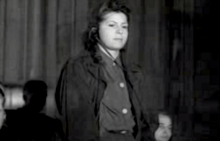Luise Danz
| Luise Danz | |
|---|---|
 Luise Danz in 1947 | |
| Born |
December 11, 1917 Walldorf (Werra) in Thuringia |
| Citizenship | German |
| Occupation | Concentration camp guard |
| Criminal charge | Crimes against humanity |
| Criminal penalty | Life imprisonment |
Luise Danz (born December 11, 1917) was a Nazi German concentration camp guard in World War II. She was born in Walldorf (Werra) in Thuringia. Danz was captured in 1945 and put on trial for crimes against humanity at the Auschwitz trial in Kraków, Poland. She was sentenced to life imprisonment in 1947, but released due to general amnesty on August 20, 1957.[1][2]
Camp work
On January 24, 1943, at the age of 25, Danz was conscripted as an SS-Aufseherin within the Nazi concentration camp system at Ravensbrück. She served as guard in several camps in occupied Poland, such as at Majdanek (1943-April 1944), Kraków-Płaszów (April 1944), Auschwitz-Birkenau (May 1944-January 1945) and also at Malchow (subcamp of Ravensbrück). In 1943 she received an award from Nazi Germany for her camp service. From 1 March 1943, she completed a three-week course on guard in the Ravensbrück concentration camp and was on March 22, 1943 in the concentration camp Majdanek added. There she oversaw the women's camp work details in the tailoring, the camp kitchen, the nursery and in the clothing store. During the evacuation of Majdanek at the end of April 1944 Danz was in the Plaszow concentration camp. Halina Nelken remembered her in Plaszow: "Danz, tall, slender, and with a gaunt, boyish face was a specialist in punching jaws with her fist and at the same time bringing her knee up into a stomach. The woman she was mistreating fainted immediately."[3]
After the evacuation of Plaszow concentration camp Luise Danz was in Auschwitz-Birkenau in September or October 1944, where she oversaw a Jewish commando in the concentration camp laundry and led the leather detail as a Kommandofuhrerin, and eventually rose to the rank of Rapportfuhrerin of the Hungarian Jewesses camp. After the evacuation of Auschwitz took place in January 1945, she was moved to Ravensbrück and on to its subcamp in Malchow. Danz became Oberaufseherin in Malchow in January 1945 upon her arrival and served in that capacity until the beginning of May 1945. In Malchow 900 female prisoners had in the local explosives factory Gesellschaft mbH for recovery of chemicals work (Verwertchemie). Danz's behavior is said to have evolved according to statements of surviving prisoners of the different camps into that of a sadist. She severely abused prisoners, for example, with her bull whip. She also aided in the hanging of Russian women prisoners and hours-long prisoner roll calls which claimed many lives from exposure and exhaustion alone.[4]
Capture and trials for war crimes
At the end of the war in 1945, Danz tried to slip into obscurity, but was discovered, captured and arrested on 1 June 1945 in Lützow and put to justice at the Auschwitz Trial by Poland for crimes she had committed while on duty in the vast German camp system. At her 1947 trial she was sentenced to life imprisonment, but was then released early in 1956 after serving nine years.
See also
References
- ↑ Staff writer (2013). "Auschwitz Trial (November-December 1947)". The Jewish Virtual Library. Retrieved 2013-04-10.
- ↑ Staff writer. "Proces oświęcimski (Auschwitz trial); 24.11.1947 – 16.12.1947". Procesy zbrodniarzy (Trials of war criminals). Majdanek Museum. Retrieved 2013-04-10.
- ↑ Halina Nelken, And Yet, I Am Here! (Gerlingen, Germany: Bleicher Verlag, 1996), pp 216-217
- ↑ Gisela Bock (2005). Die Aufseherin Luise Danz. Genozid und Geschlecht: jüdische Frauen im nationalsozialistischen Lagersystem. Campus Verlag. pp. 71–77. ISBN 3593377306.
- Dublon-Knebel, Irith (2005). "‘Erinnern kann ich mich nur an eine Frau Danz...’: Die Aufseherin Luise Danz in der Erinnerung ihrer Opfer". In Bock, Gisela. Genozid und Geschlecht. Jüdische Frauen im nationalsozialistischen Lagersystem. Frankfurt am Main: Campus. pp. 66–84. ISBN 3-593-37730-6.